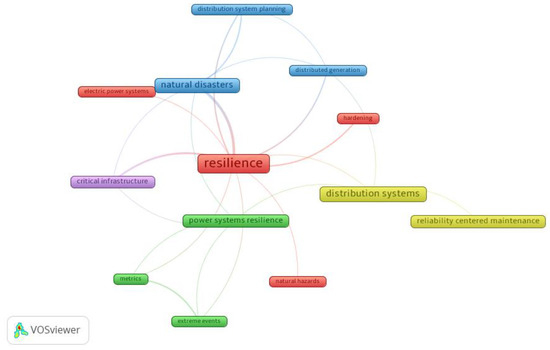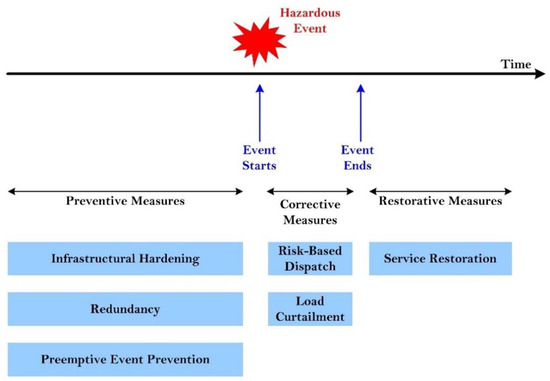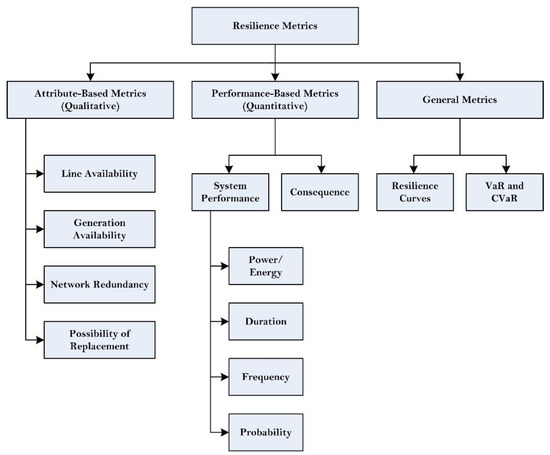Extreme weather events are one of the main causes of large-scale power outages in distribution systems. The changing climate has led to an increase in the frequency and severity of these events, which, if not mitigated, are expected to lead to more instances of widespread outages and the severe societal and economic damages that ensue. Protecting the power grid against such events, which are high impact yet low frequency, requires a paradigm shift in grid design practices. In recent years, many researchers have focused on the resilience of the power grid against extreme weather events by proposing various grid hardening and/or redundancy solutions. The goal of this document is to provide a review of the most commonly used definitions and metrics for resilience, with a discussion of solutions to achieve infrastructural resilience for the power grid.
1. Introduction
The increase in power outages associated with adverse weather events in the United States has had significant economic ramifications. Climate change has exacerbated the occurrence of extreme weather events such as hurricanes, heat waves, wildfires, and snowstorms. This, combined with increased power demands, is now regularly causing billions of dollars’ worth of damage due to resultant power grid disruption. Between 2003 and 2012, 679 power outages were caused, which affected at least 50,000 customers, and up to 90% of these failures are attributed to disruptions in the distribution systems [
1]. Some of the more prominent occurrences in recent memory include Hurricane Sandy in 2012, which left 8.5 million people without power [
1]; the 2021 Texas winter storm, which affected a million residents [
2,
3]; and the 2017 Hurricane Irma in Puerto Rico, which affected power distribution to 6.7 million customers [
4]. The economic costs associated with these disasters run into the hundreds of billions and, at the same time, lead to significant societal damage. For instance, the Texas winter storm resulted in multiple deaths because electric heaters and medical equipment could not run without power, leaving vulnerable people exposed to extreme cold and/or without critical life support [
2,
3]. One reason why power systems are particularly vulnerable to extreme weather events is that they are mainly designed and optimized for normal weather conditions and are not equipped to handle less common extreme weather events. While this is economically viable in the short term, it exposes the power grid to catastrophic failures that are costlier in the long run. Another essential dynamic to consider is that disasters that lead to shocks and stresses are often connected, making the risk two-fold. As such, the risk is multidimensional and self-perpetuating. For example, higher temperatures due to climate change result in higher power demands, therefore increasing the load on the power system. At the same time, there is a higher risk of adverse weather events, which means that when disaster strikes, it finds an already compromised power grid that is easier to knock down. It is, therefore, paramount that utility companies strengthen their systems’ readiness for extreme events. During the past decade, there has been much focus in the literature on the resilience of the electric power grid against large-scale disturbances, mainly natural disasters.
Figure 1 illustrates a keyword co-occurrence map of the recent publications on power grid resilience.
Figure 1. Keyword co-occurrence clustering view, made with VOS viewer, for references used here related to power grid resilience.
Although more attention has been given recently to making the grid more resilient, a standard definition for power system resilience does not exist in the literature, and while different researchers are generally converging to the same sets of criteria, various definitions are being presented and adopted. A common theme for a resilient power system is one that has the capacity to withstand disturbances and continue to deliver energy to customers [
5]. Some have further specified that resilience is defined against extraordinary events, referred to as high impact low frequency (HILP) events [
6,
7]. Many studies in literature specifically focus on the resilience of the power distribution grid [
8,
9,
10,
11,
12,
13,
14,
15,
16,
17] as it is more closely related to customers. For this, most use the definition from the US Federal Energy Regulatory Commission (FERC) [
18], in which resilience is defined as “the ability to withstand and reduce the magnitude and/or duration of disruptive events, which includes the capability to anticipate, absorb, adapt to, and/or rapidly recover from such an event”. Here, being able to withstand an event is further broken down into the ability to absorb its impacts and adapt to the changes caused by it. Moreover, the ability to anticipate the event is considered as yet another dimension of resilience. The definition by CIGRE working group C4.47 introduces additional dimensions listed as anticipation, preparation, absorption, sustainment of critically operated systems, swift recovery, adaptation, and implementation of the learned lessons from previous events [
19]. In a more general context, the National Infrastructure Advisory Council (NIAC) [
13] has listed four attributes of a resilient system, which are robustness, resourcefulness, rapidity, and adaptability: Robustness is the capacity of the system to withstand the impacts of an event without suffering severe performance deterioration or loss. Resourcefulness is the ability to initiate a solution by mobilizing resources such as information, capital, technology, and manpower. Rapidity is the ability to restore functionality and mitigate losses quickly. Finally, adaptability is the capability to learn new information from a HILP event and dispatch new solutions to increase the dimensions of robustness, resourcefulness, and recovery before the next event.
Strategies to improve resilience can be divided based on the timeline of the HILP event as preventive measures, which are adopted before the onset of the event; corrective measures, implemented during the course of the event; and restorative measures, which are employed after the event has run its course. Although these are decoupled from one another based on the timeline of their deployment, they can still impact the success rate of their counterparts. For instance, grid-hardening techniques that are normally implemented long before the onset of an event can lead to higher chances of success for a risk-based grid dispatch as the event is unfolding. Depending on the type and characteristics of the HILP event, some of these mitigation measures may be prioritized over others. For instance, solutions against short-duration events such as earthquakes are mainly focused on prevention and restoration, whereas for events that run a longer course, e.g., most weather-induced natural disasters, all mitigation aspects are considered. Figure 2 illustrates some of the general resilience solutions that can be applied in power systems.
Figure 2. Overview of strategies for power grid resilience.
Before the onset of an upcoming HILP event, resilience can be achieved by hardening the infrastructure, e.g., using stronger overhead line poles/towers or reinforcing them by installing guy wires, elevating substations in flood zones, waterproofing control rooms, or replacing overhead conductors with underground cables. Pre-emptive strategies can also be adopted by reducing the chances of disturbances and/or outages, for instance by increasing the distances between phase conductors to reduce the chances of flashover due to conductor slapping or vegetation management to prevent line contract with tree branches. Lastly, redundant designs can be employed to increase the resilience of the power grid. Some examples could be installing multiple circuits in parallel, using main and backup transformer units, or expanding the generation reserve capacity of the system by deploying additional centralized or distributed energy resources. These solutions are naturally costly and take place over a longer horizon.
During the course of the event, however, the focus must be shifted to adaptive operation. The availability of lines, transformers, and/or generation resources may be impacted by the event, in which case, energy dispatch needs to adjust by supplying power via more reliable resources and/or routing power through more secure lines and substations. Load curtailment, either voluntary in the form of demand response or involuntary in the form of load shedding, may also be adopted to ensure the stability of the power system. Due to the possible uncertainties associated with the nature of most HILP events, i.e., their intensity, scope, or trajectory, the corrective energy dispatch must be risk-based in order to protect the grid against all likely scenarios. Finally, during the restoration phase, it is assumed that the event has ended and, as such, the focus is on using alternate energy sources and alternate routes to provide power to the outage area, i.e., healthy parts of the grid that are left de-energized due to the event. Various network reconfiguration strategies may be used here to allow for higher connectivity.
2. Resilience Metrics
Resilience metrics, also known as resilience indices or indicators, are a means for evaluating the level with which a power system can withstand a HILP event. The concept of resilience is complex and dynamic. Traditional reliability metrics such as the System Average Interruption Frequency Index (SAIFI), System Average Interruption Duration Index (SAIDI), Customer Average Interruption Duration Index (CAIDI), and other related indicators cannot be used here due to their inability to model catastrophic HILP events. In general, resilience metrics can be categorized into three groups: attribute-based, performance-based, and general. A breakdown of these groups can be seen in Figure 3.
Figure 3. Classification of resilience metrics.
Selecting the appropriate metric entails balancing trade-offs some of which are outlined in [
20]. For instance, more complex metrics may need a larger quantity of data and higher technical expertise to be integrated into the model. On the other hand, less complex metrics need less data and are easier to develop and integrate; however, may be less effective in providing a true representation of the system’s resilience. In addition, metrics can be
retrospective, assessing the system’s performance during past events, or
prospective, predicting the system’s resilience against impending or anticipated shocks. It is the responsibility of the analyst to prioritize trade-offs based on the objectives of the study and the availability of resources (data and expertise).
3. Power Grid Infrastructural Resilience
Various strategies exist that can improve the infrastructural resilience of the power system against HILP events. Most of these techniques focus on either reinforcement of grid components or creating redundancy in design. Some examples are provided below.
3.1. Reinforcing Overhead Line Structures
The majority of power transmission and distribution networks are supported by overhead lines, mainly due to their lower costs compared to underground cables. In order to ensure safe and secure operation and avoid potential flashovers, sufficient safety clearances must be maintained between a conductor and other structures such as other conductors, the tower, nearby equipment, or trees and vegetation nearby. Safety clearances are standardized based on system voltage levels but must also take into account environmental factors such as average wind speeds in the region or extreme ambient temperatures. Extreme weather events can increase the chances of flashovers, e.g., contact between phase conductors (slapping) due to high winds, or excessive conductor sag due to extreme ambient temperatures (or conversely, due to excessive icing load). In addition, overhead towers and poles are vulnerable to extreme weather events such as high winds of tornadoes and hurricanes or excessive icing load during winter storms.
Overhead line structures can be reinforced in a variety of ways, for instance, by upgrading wooden poles to metal lattices, using stronger materials for the towers, increasing the safety clearances between conductors and grounded objects or other conductors, or using guy wires to provide extra support against high winds. Of course, the typical lengths of overhead lines will significantly add to the costs. Hence, such approaches can be implemented for sections of the circuit that are more at risk.
3.2. Vegetation Management
Vegetation growth near overhead structures can cause several issues. Tree branches can grow close to the line, causing a flashover, or strong winds can result in branches swaying close to the conductor or snapping and falling on it. In fact, broken tree branches falling on overhead lines are believed to be the primary reason for distribution network power outages during storms in the United States [
38]. To avoid these problems, many utilities perform regular vegetation management to maintain a restricted vegetation area near those structures. These practices are governed by certain standards and legislation [
38,
39].
3.3. Underground Cabling
An alternative to the reinforcement of overhead structures is to replace them with underground cables. These cables are protected against most weather events, and hence, are less likely to be affected by environmental factors. Constructing an underground cable, however, can be significantly more expensive than installing an overhead line, depending in part, on the voltage level and environmental factors [
40]. In addition, locating a fault in an underground cable is more challenging and time-consuming, which can increase the cost of maintenance. Hence, any cabling project must carefully weigh the costs and benefits. In fact, it is believed that selective undergrounding, as opposed to a complete replacement, may provide the optimum return on investment. It should also be pointed out that underground cables are more susceptible to surge flooding, which frequently occurs following hurricanes [
40].
3.4. Hardening Substations
Substations house transformers, breakers, disconnect switches, busbars, and sometimes control and protection assets. Failure of a substation due to an extreme event may, under certain circumstances, force all connecting lines to go out of service, leading to a major outage. Substations, such as overhead lines, are exposed to all environmental events, and air-insulated substations are particularly susceptible to storms and debris. Substations also face a significant threat from flooding, especially in coastal areas where storm surges, tropical precipitation, or tsunamis are more likely to occur. Improved flood monitoring is one way to protect substations, since it allows the system operator to de-energize the system before it gets damaged or loses control. Elevating substations and utilizing modular, enclosed components is another option that may be economically feasible, particularly at distribution voltage levels [
41]. The cost–benefit may not justify the transformation at the transmission level due to having significantly higher safety clearances, which may require raising the substation to a much higher level. Of course, no matter the costs, substation relocation or elevation may still be less expensive than the construction and upkeep of adequate flood protection in the form of berms and dams [
41].
3.5. Network Redundancy
Adding redundancy to the power network can also increase its resilience. This includes building additional (perhaps parallel) transmission and distribution lines and increasing their capacity to be able to handle higher loads if other parts of the network fail. In addition, providing alternate routes with network reconfiguration means can allow for the bypassing of damaged lines, lowering the likelihood of cascading failures.
This entry is adapted from the peer-reviewed paper 10.3390/en16010064



